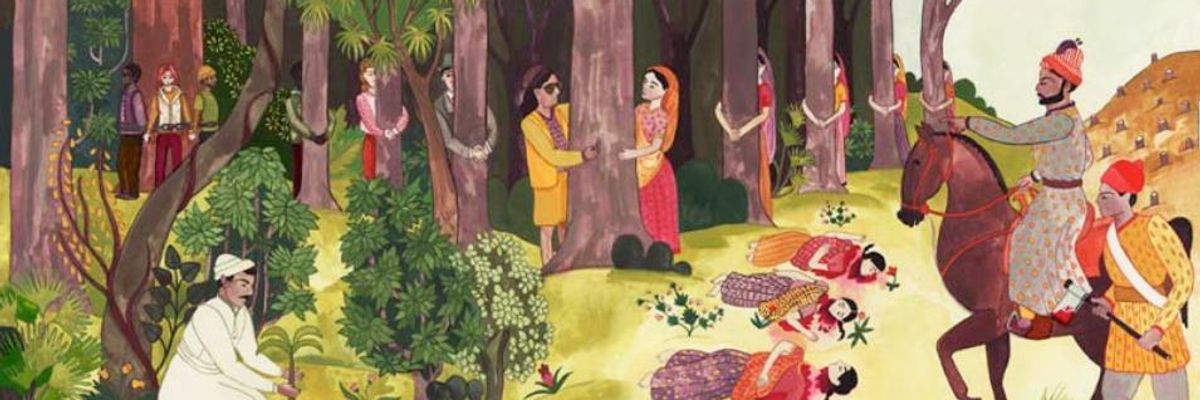On Sept. 21, 2014, the People's Climate March will commence in New York City as world leaders gather for a United Nations emergency summit on climate change. Thousands of organizations have signed on and many demonstrations have been planned across the country on that day. Perhaps more than one million people will descend on Manhattan Sept. 21 to support environmental and human survival. Almost inevitably, someone from the media or a prior or the current administration will throw around the label "tree hugger" and no one will be shocked. In preparation for the march and in reflecting on the perceived negativity of this label, I've been thinking about the heroines of the Chipko ("tree-hugging") movement in India.
In 1730, Amrita Devi watched men with axes enter her village with an order from the Maharajah -- to cut down trees needed to build his new palace. The trees were the villagers' source of life, the only green in an otherwise barren landscape. The forest shielded the people from the desert, protected their fragile water supply and provided fodder for the cows and twigs for the fire. What's more, the trees and animals were sacred and not to be harmed, according to the rules of their Hindu sect.
Amrita Devi tried to reason with the men, but they had their orders. They entered the forest with axes raised. Amrita Devi boldly walked past the bewildered men and stretched her thin arms around a tree saying, "If a tree is saved, even at the cost of one's head, it is worth it."
Amrita Devi was beheaded protecting the trees. When her three daughters stepped up to take her place, they, too, were beheaded. It is said that 363 villagers were killed that day, trying to save the trees that were essential to their lives.
When the Maharajah heard about the massacre, he was appalled at the loss of life. As the story is told, he declared a permanent injunction against felling the trees or killing the wildlife in the area of the massacre and exempted the villages of that region from land taxes. Today, the Bishnoi villages of Jodhpur are a tourist attraction, green and beautiful, filled with animals and birds, in an otherwise desolate region. Amrita Devi is honored as one of the world's first eco-warriors.
The Chipko Movement was reborn in the 1970s as developers descended on the Himalayan forests seeking short-term profit. Deforestation led to environmental disasters. In monsoon season, landslides and floods devastated the regions where tree roots once secured the land.
One day in March 1974, when the men of Reni were away, laborers with axes and guns showed up with government permits to fell the trees. A little girl saw them and raced to get Gaura Devi who quickly alerted 27 other women. Together, they marched to the forest and confronted the men.
Gaura Devi (1925-1991) was unschooled, but wise. She said, "Brothers, this forest is like our mother. You will have to shoot me before you can cut it down." The men laughed.
Dodging obscenities and threats, the women stood between the men and the trees until the workers, frustrated and exhausted, backed down. It took months of vigilance and protest, but the people, with women in the lead, saved their trees.
The rural Chipko movement has been an inspiration to ecology activists around the globe. In 2008, twig sculptures of the tree-hugging women created by Klub Gaja, a Polish environmentalist group, greeted delegates at the entrance to the UN's climate change conference in Poznan, Poland.
How can I, a woman living in 21st century New York City, understand this story? If I'm thirsty, I turn the tap, and clear, drinkable water comes out. If I want to cook my dinner, I turn another knob and a small, controllable ring of fire appears on my stovetop. I can't imagine using 85 percent of my time walking to get water or firewood. Can any of us?
But then, I remember the water crisis in Detroit, droughts in California, Texas and the Great Plains region, mountaintop removals and coal mine exploitation in West Virginia, deforestation of the Southeastern U.S. for European utilities and the 2,000 square miles of Louisiana coastline that has disappeared in the past 80 years. Across the U.S., we're all facing environmental degradation and the adverse affects of climate change - in our own backyards. If the term "tree hugger" means valuing long-term life - the lives of our family members and communities - over short-term profits, then perhaps it's not such a bad name after all. When it comes to the security and safety of our families, we're all a little "tree hugging" by default. In any case, we're well past the time for "tree hugging." It's really all about "life saving" at this point.
